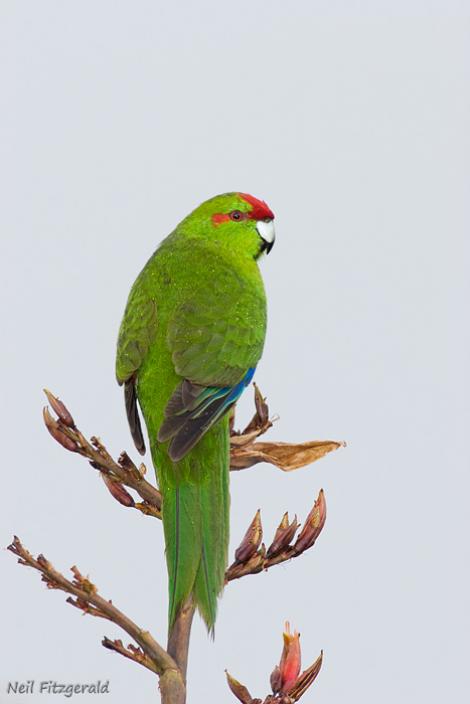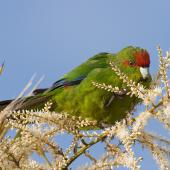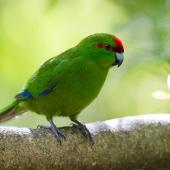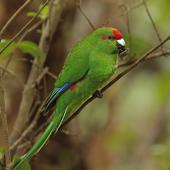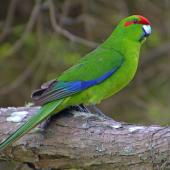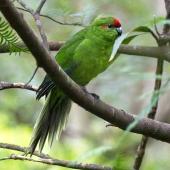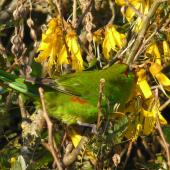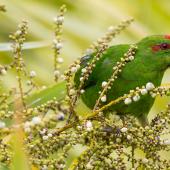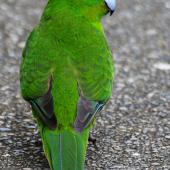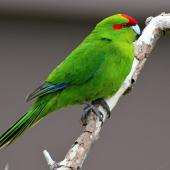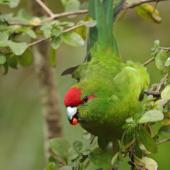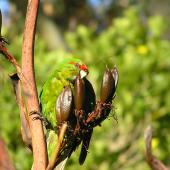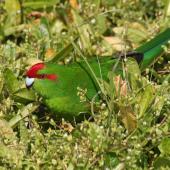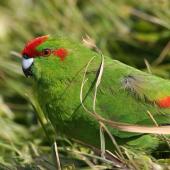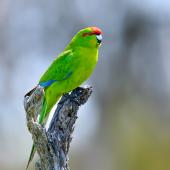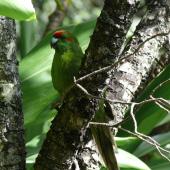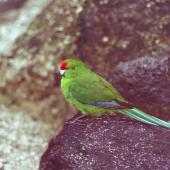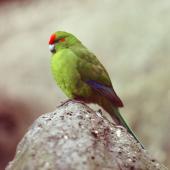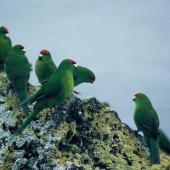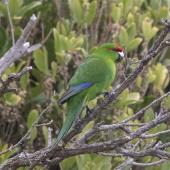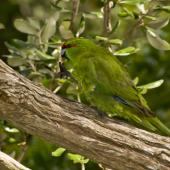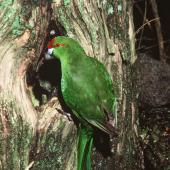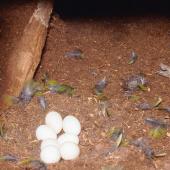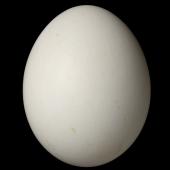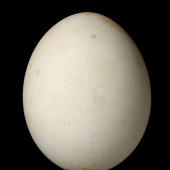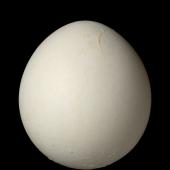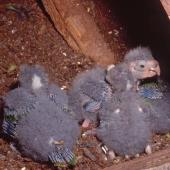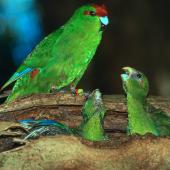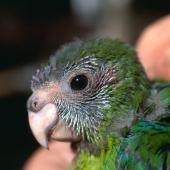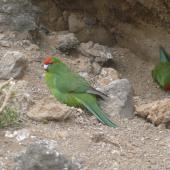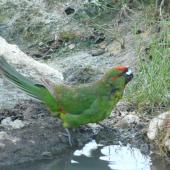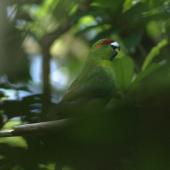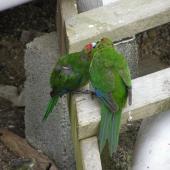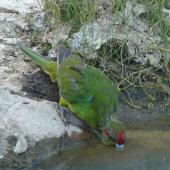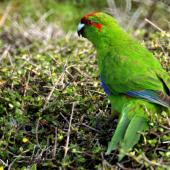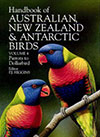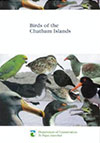Red-crowned parakeet | Kākāriki
Cyanoramphus novaezelandiae (Sparrman, 1787)
Order: Psittaciformes
Family: Psittaculidae
Other names: red-headed parakeet, kakariki, kaka-wairiki, kawariki, porete, powhaitere, redcrowned parakeet, red crowned parakeet
Geographical variation:
Three extant subspecies recognised: cyanurus on the Kermadec Islands, novaezelandiae from the Three Kings Islands south to the Auckland Islands, including the main islands, and chathamensis on the Chatham Islands. The taxonomic relationships of extinct populations on Lord Howe Island (subflavescens) and Macquarie Island (erythrotis) requires further study.
Red-crowned parakeets are medium-sized, emerald green parrots with an obvious red crown. Although they are widely distributed throughout the New Zealand region, and very common on some islands, they are almost entirely absent from the two main islands. One exception is Wellington city, where birds dispersing from Zealandia and Matiu/Somes Islands are occasionally seen in suburban gardens. Red-crowned parakeets occupy a variety of habitats ranging from tall forests to grass and shrublands. In the late 1800s, this species sometimes occurred in large flocks with two other species of Cyanoramphus parakeets, causing considerable damage to orchards.
Identification
Red-crowned parakeets are medium-sized, long-tailed parrots with broad, rounded wings and predominantly emerald green plumage. They have a crimson forehead and fore-crown, and patches of the same colour behind the eyes and on each flank, at the base of the tail. The leading edge of the primary wing feathers are a rich cyan blue of varying extent depending on subspecies. Males are larger than females. Their flight appears to be erratic when crossing open spaces, but they are capable of crossing open ocean in excess of 100 km.
Voice: a characteristic parakeet chatter, with variety of softer tur-tur-tur calls.
Similar species: where parakeet distribution overlaps, field identification can be difficult. A good view of crown colouration is the only reliable feature. Other differences are subtle, including plumage tone (bluish-green to yellowish-green), the width and intensity of blue on the wings, and slight difference in the pitch of calls, with the larger red-crowned parakeet having a lower pitched call than those of yellow-crowned parakeets.
Distribution and habitat
Formerly common throughout New Zealand, red-crowned parakeets are now largely restricted to pest-free offshore and outlying islands, from the Kermadec Islands east to the Chatham Islands and south to the Auckland Islands. Occasional mainland sightings are likely to be vagrants, released or escaped captive birds, or birds dispersing from nearby offshore islands or pest-free mainland reserves. Locally common on pest-free offshore islands from sub-tropical Kermadec Islands (especially Raoul and Macauley Islands), Three Kings Islands, Poor Knights, Islands many islands in the Hauraki Gulf, Alderman Islands, Mercury Islands, Bay of Plenty islands, Kapiti Island, Whenua Hou/Codfish Island, some of the muttonbird islands, and subantarctic Enderby and Adams Islands (Auckland Islands). Reintroduced to Tiritiri Matangi, Cuvier Island, Motuhora/Whale Island, Matiu/Somes Island, Motuihe Islands, Moturua Island (Bay of Islands), and Zealandia (Wellington), Tawharanui Regional Park and Shakespeare Regional Park. Red-crowned parakeets inhabit a variety of habitats, ranging from grass-covered islands (e.g. Macauley and Burgess Islands) to large heavily forested islands (e.g. Hauturu/ Little Barrier Island).
Population
Red-crowned parakeets are locally common to abundant in suitable habitat. Large fluctuations in population size not uncommon, and are dependent on interannual environmental conditions particularly availability of food and (on some islands) water. Few population estimates are available. The population on 306 ha Macauley Island (Kermadec Islands) was estimated at 10,000 birds in November 1980, 17,000 to 20,000 birds in September 1988, fewer than 2,000 birds in November 1988, and 3,500 birds in July 2002.
Threats and conservation
North Island and South Island mainland populations were eliminated through predation by introduced mammals (particularly rats, stoats and cats). Several island populations have been established or re-established by translocation of wild birds (e.g. Matiu/Somes, Motuihe and Tawharanui Peninsula) or captive-reared birds (e.g. Tiritiri Matangi, Cuvier & Motuhora/Whale Islands). Red-crowned parakeets are commonly kept in captivity in New Zealand and overseas (particularly Australia). This species is known to hybridise with other Cyanoramphus species in the wild and in captivity. Genetic ‘pollution’ of the captive stock has resulted in a ban on these birds being used for any further captive to wild translocations. Hybridisation between Chatham Island red-crowned parakeets (C.n. chathamensis) and Forbes’ parakeet (C. forbesi) on highly modified Mangere Island resulted in a hybrid swarm severely threatening the genetic integrity of endangered Forbes’ parakeets. Although common on many islands, red-crowned parakeets populations remain vulnerable to introduction (or reintroduction) of these pests and to introductions of parrot-specific diseases (e.g. Parrot Beak and Feather Disease).
Breeding
Red-crowned parakeets have been recorded breeding year round, with the main breeding period subject to regional variations. They are cavity-nesters, preferring hollows in trees but also using holes in the ground, in cliff faces, talus slopes and under dense vegetation. The average clutch size for the nominate subspecies is 7 (range 4 to 9). Female parakeets are responsible for all nest preparation, incubation, brooding and feeding of chicks until 10-14 days of age, with all food provided to her by her mate. Thereafter, male and female parakeets feed chicks at the nest until fledging and independence. Egg-laying takes several days to complete, with incubation usually commencing after the second egg is laid. Incubation takes approximately 23 days, and the chicks hatch asynchronously, so there is a large variation in chick size within a brood. Nestling period varies widely depending on hatch order (nestling period 32-49 days). The last chicks to hatch usually fledge at an earlier age and are less developed than their older siblings. More than one brood may be attempted if the initial nest fails or if food supply allows.
Behaviour and ecology
Red-crowned parakeets have colonised and adapted to a range of environments and habitats on islands from the tropics to the subantarctic. Despite their rather erratic flight they are strong fliers and readily move within island groups searching for seasonal foods. When environmental conditions are good they are able to breed quickly, leading to rapid increases in population size. Red-crowned parakeets often forage for food on the ground or within low shrubby vegetation, making them vulnerable to ground-hunting predators.
Food
Red-crowned parakeets are omnivorous, but eat mainly seeds, flowers and fruit from numerous plant species. Invertebrates, particularly scale insects, are eaten in spring before breeding. Kermadec red-crowned parakeets have been recorded scavenging marine molluscs on Macauley Island.
Websites
http://www.terranature.org/parakeetred-crowned.htm
References
Greene, T.C. 1998. Foraging ecology of the red-crowned parakeet (Cyanoramphus novaezelandiae novaezelandiae) and yellow-crowned parakeet (C. auriceps auriceps) on Little Barrier Island, Hauraki Gulf, New Zealand. New Zealand Journal of Ecology 22: 161-171.
Greene, T.C. 2003. Breeding biology of red-crowned parakeets (Cyanoramphus novaezelandiae novaezelandiae) on Little Barrier Island, Hauraki Gulf, New Zealand. Notornis 50: 83-99.
Higgins, P.J. (ed.) 1999. Handbook of Australian, New Zealand and Antarctic birds. Vol. 4, parrots to dollarbird. Oxford University Press, Melbourne.
Miskelly, C.M.; Powlesland, R.G. 2013. Conservation translocations of New Zealand birds, 1863-2012. Notornis 60: 3-28.
Taylor, R.H. 1985. Status, habits and conservation of Cyanoramphus parakeets in the New Zealand region. ICBP Tech. Publ. 3: 195-211.
Veitch, C.R.; Miskelly, C.M.; Harper, G.A.; Taylor, G.A.; Tennyson, A.J.D. 2004. Birds of the Kermadec Islands, south-west Pacific. Notornis 51: 61-90.
Recommended citation
Greene, T.C. 2013 [updated 2022]. Red-crowned parakeet | kākāriki. In Miskelly, C.M. (ed.) New Zealand Birds Online. www.nzbirdsonline.org.nz
Red-crowned parakeet | Kākāriki
- Breeding season
-
- Jul
- Aug
- Sep
- Oct
- Nov
- Dec
- Jan
- Feb
- Mar
- Apr
- May
- Jun
- Egg laying dates
-
- Jul
- Aug
- Sep
- Oct
- Nov
- Dec
- Jan
- Feb
- Mar
- Apr
- May
- Jun
Kermadec parakeet
- Social structure
- monogamous
- Breeding season
-
- Jul
- Aug
- Sep
- Oct
- Nov
- Dec
- Jan
- Feb
- Mar
- Apr
- May
- Jun
- Nest type
- burrow, tree hole
- Nest description
- Natural cavities, usually within trunk or large limb of tree but will use cavities on ground, rock piles, cliffs, abandoned petrel burrows and dense ferns.
- Maximum number of successful broods
- More than 1 with food abundance
- Clutch size (mean)
- 2-5
- Clutch size (min)
- 2
- Clutch size (max)
- 5
- Mean egg dimensions (length)
- 27.10 mm
- Mean egg dimensions (width)
- 21.20 mm
- Egg colour
- Lustreless white
- Egg laying dates
-
- Jul
- Aug
- Sep
- Oct
- Nov
- Dec
- Jan
- Feb
- Mar
- Apr
- May
- Jun
- Interval between eggs in a clutch
- Unknown
- Incubation behaviour
- female only
- Incubation length (mean)
- Unknown
- Nestling type
- altricial
- Nestling period (mean)
- 32-40 days
- Nestling period (min)
- 32 days
- Nestling period (max)
- 40days
- Age at fledging (mean)
- 32-40 days
- Age at fledging (min)
- 32days
- Age at fledging (max)
- 40days
- Age at independence (mean)
- Unknown
- Age at first breeding (typical)
- First breeding < 1 years
- Maximum longevity
- Unknown
- Maximum dispersal
- Unknown
Red-crowned parakeet
- Social structure
- monogamous
- Breeding season
-
- Jul
- Aug
- Sep
- Oct
- Nov
- Dec
- Jan
- Feb
- Mar
- Apr
- May
- Jun
- Nest type
- tree hole
- Nest description
- Natural cavities usually in trunk or large limb of tree but will use cavities on ground, rock piles and cliffs.
- Nest height (mean)
- 2.90 m
- Nest height (min)
- 0.00 m
- Nest height (max)
- 6.40 m
- Maximum number of successful broods
- More than 1 with food abundance
- Clutch size (mean)
- 7
- Clutch size (min)
- 4
- Clutch size (max)
- 9
- Mean egg dimensions (length)
- 25.80 mm
- Mean egg dimensions (width)
- 20.70 mm
- Egg colour
- Lustreless white
- Egg laying dates
-
- Jul
- Aug
- Sep
- Oct
- Nov
- Dec
- Jan
- Feb
- Mar
- Apr
- May
- Jun
- Interval between eggs in a clutch
- 1-3 days
- Incubation behaviour
- female only
- Incubation length (mean)
- 23.6 days
- Incubation length (min)
- 23days
- Incubation length (max)
- 25days
- Nestling type
- altricial
- Nestling period (mean)
- 40.8
- Nestling period (min)
- 32 days
- Nestling period (max)
- 49days
- Age at fledging (mean)
- 40.8 days
- Age at fledging (min)
- 32days
- Age at fledging (max)
- 49days
- Age at independence (mean)
- 28-35 days
- Age at independence (min)
- 28 days
- Age at independence (max)
- 35 days
- Age at first breeding (typical)
- <1 year
- Maximum longevity
- Unknown
- Maximum dispersal
- Unknown
Chatham Island red-crowned parakeet
- Social structure
- monogamous
- Breeding season
-
- Jul
- Aug
- Sep
- Oct
- Nov
- Dec
- Jan
- Feb
- Mar
- Apr
- May
- Jun
- Nest type
- tree hole
- Nest description
- Natural cavities, usually in trunks or large limb of tree but will use cavities on the ground, rock piles, cliffs and dense vegetation.
- Maximum number of successful broods
- More than 1 with food abundance
- Clutch size (mean)
- 5-7
- Clutch size (min)
- 5
- Clutch size (max)
- 7
- Mean egg dimensions (length)
- 25.60 mm
- Mean egg dimensions (width)
- 20.90 mm
- Egg colour
- Lustreless white
- Egg laying dates
-
- Jul
- Aug
- Sep
- Oct
- Nov
- Dec
- Jan
- Feb
- Mar
- Apr
- May
- Jun
- Interval between eggs in a clutch
- Unknown
- Incubation behaviour
- female only
- Incubation length (mean)
- Unknown
- Nestling type
- altricial
- Nestling period (mean)
- Unknown
- Age at fledging (mean)
- Unknown
- Age at independence (mean)
- Unknown
- Age at first breeding (typical)
- <1year
- Maximum longevity
- Unknown
- Maximum dispersal
- Unknown
Macquarie Island parakeet
- Social structure
- monogamous
- Breeding season
-
- Jul
- Aug
- Sep
- Oct
- Nov
- Dec
- Jan
- Feb
- Mar
- Apr
- May
- Jun
- Nest type
- tree hole
- Egg laying dates
-
- Jul
- Aug
- Sep
- Oct
- Nov
- Dec
- Jan
- Feb
- Mar
- Apr
- May
- Jun
- Incubation behaviour
- female only




